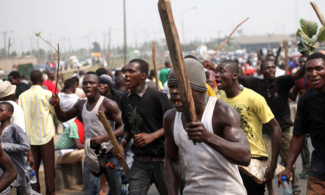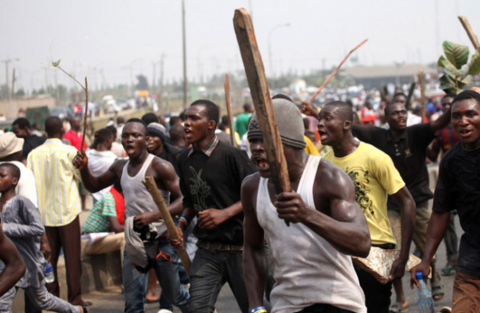
Naked bodies smeared in charcoal and red mud paste, snail shells tied around bared waist, sticks and stones striking the victim from every angle as the crowd jeered and booed at their heels.

Last night, my phone pinged with a WhatsApp video of a woman being stripped naked and beaten by what appeared to be an angry mob of men, I was appalled. I stopped watching halfway through and went online to read up what information I could find. The commentary described how she was further subjected to violence and humiliation, with no one stepping in to help.
Naked bodies smeared in charcoal and red mud paste, snail shells tied around bared waist, sticks and stones striking the victim from every angle as the crowd jeered and booed at their heels.
This was a common punishment for alleged thieves in the primary school I attended and on the streets where I spent some of my formative years playing in Benin City. My teachers said this barbaric act was meant to serve as both punishment and deterrent, a community intervention to get the victim back on the straight and narrow – I don’t know about that, but I recall never seeing classmates/schoolmates who’d undergone this in school – thinking about it some 20 odd years later now, I never heard about them again. I am left to wonder how their life turned out. Were it not for my parent’s intervention, I may have grown up to normalise this behaviour that justified the treatment of another person this way.
This violent mob action has made a major comeback and it seems, we are all guilty bystanders.
As I ponder the video from last night, and recall the events of my childhood, I wonder how we’ve become so desensitised and if acting within a mob emboldens us to act in ways we ordinarily would never consider or condone?
The mob, jury and executioner
I was discussing with a friend a few years ago about a video of another woman who had been stripped naked, beaten and sexually assaulted by an angry mob after she was accused of stealing stock cubes. Why are they so angry, why do they act out like this, I asked? After a long pause, my friend answered, “Because we are angry, frustrated, unseen, unheard, disempowered. No one cares, what options do we have? We can’t reach the politicians robbing us blind, or the police that are so corrupt they make arrests for profit… so we take it out on each other.” How true this was and still is. The ‘common thief’ we can reach and beat and burn has become a symbol of every person who has treated us unjustly, and in burning, maiming, hurting them, we claim just a bit of revenge for all we’ve been made to endure.
Very easily, people who’ve harboured unresolved grievances without an outlet erupt into violent crowds, taking on the identity of the mob. It doesn’t take long for them to be whipped into a murderous frenzy.
These lynchings are both the cause and symptom of a bigger societal problem. We do not trust the criminal justice system to investigate and prosecute criminals, hence, may not see the need in handing over alleged criminals and because we believe the system to be corrupt, inefficient and ill-equipped, we are emboldened within a mob to act in cruel ways, in their stead, as we are almost assured we will get away with it – even in the age of social media and videos going viral.
It remains to be seen if the anti-mob lynching Bill, that recently passed its second reading in the Senate will be a strong enough deterrent when passed into law.
Though there seem to be no rhyme or reason to how people turn into victims of jungle justice, it is evident that those most at risk are the poorest, most vulnerable among us. For example: old women and very young children, disabled people, people with undiagnosed mental illness, poor people, marginalised groups like the LGBTQI community. Accusations can range from being a harbinger of bad luck, witchcraft, stealing, blasphemy or something as innocuous as being in the wrong place at the wrong time.
A powerless bystander?
In 2017, a nineteen-year-old girl from Ohio, USA was sentenced to nine months in jail for filming the rape of her 17-year-old friend and posting it online.
This seeming disinterest in crime happening around us is described as the bystander effect. It is not new.
Coined in the 1960’s in the aftermath of the rape and murder of Kitty Genovese, the bystander effect is a social phenomenon that states that people are less likely to intervene in negative or dangerous situations if they are part of a group rather than when they are alone.
Researchers found that the more people who witness a crime, the less likely any are to respond, as others assume someone else will step in to help or conclude there may not be a problem if someone else hasn’t intervened already.
The advent of social media has seen the bystander effect take on a new form. While in the past, our options were limited to one of these two: step in or not step in, today however, a third option – pull out our phones and film – has presented itself, thereby creating a ‘safe and sterile’ distance between us and the victim, between us and the crime, between us and the solution.
Technology and social media have proved to be indispensable in solving crimes, long after their commission, which begs the question ‘what role do they play in the criminal events as they unfold?’ Has technology turned us into dispassionate observers lacking empathy, who believe the only real power we have, the only real change we can make is by documenting events on our cell phones?
Some have argued they feared for their safety hence their reason for not intervening, and this is and should be a real concern; others say they needed to film instead of intervene for evidence but I argue that if we feel emboldened enough to film, surely, we must have been able to call the police or others for help?
So what can we do in the absence of these overt actions? According to Dr Jackson Katz, there is a third way. We can change attitudes and minds by speaking with those nearest to us, and challenging and interrupting others – friends, relatives, colleagues, and acquaintances when they engage in or evidence these behaviours. After all, the people who murder, violently assault and abuse others as part of a mob do not exist in isolation, they live, breathe and walk among us.